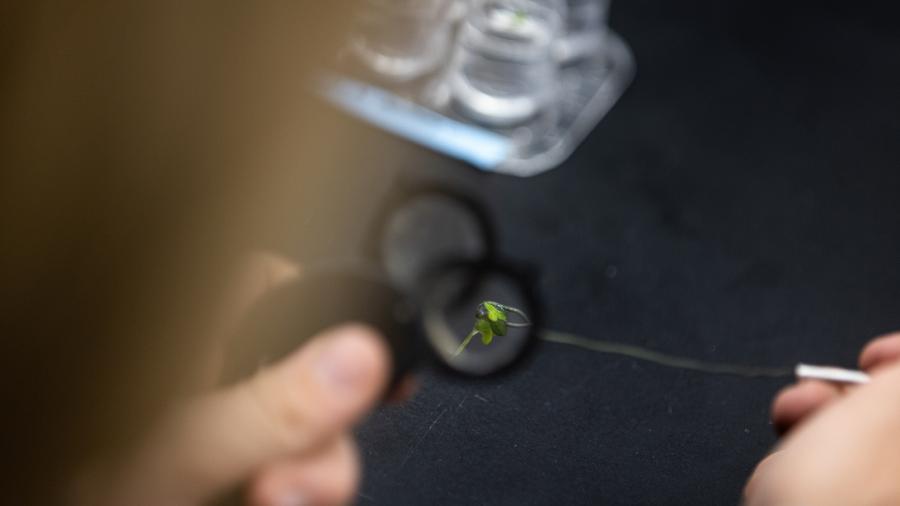University of Wisconsin-Stout sophomore Carli Capistrant separated tiny bits of duckweed to put into vials containing water she and her classmates collected at two Dunn County creeks during Biology 111: Science, the Environment and Sustainability.
The goal is to determine if Galloway Creek, which runs through the city of Menomonie, or Gilbert Creek, located about 10 minutes west of the city, will grow more duckweed over three weeks, showing which creek water has more nutrients.
The sophomore business administration major from Cottage Grove, Minn., enjoys the class and is excited to be doing real research in a general education course.
“I like to get outside and deal with real issues,” Capistrant said. “It’s interesting just to see why the waters are polluted and how to better keep them clean. I think it broadens my horizon to know what is going on in the water and the earth.

“It definitely will impact how I treat water. It makes me want to have more sustainable practices and use less fertilizer and less water, and really be more sustainable in how I live,” she said.
Students donned wader boots and collected water samples this fall over three weeks at the creeks. They observed the areas around the creeks, including trash around Galloway Creek, and the agricultural setting around Gilbert Creek, Capistrant said.
Duckweed growth shows nutrients
Nicole Hayes, assistant professor of biology, teaches the course. Using creek water and duckweed, the experiment will help show students the nutrient pollution in the waterways.
“It’s great because it encourages students to be aware of the environment and that science is happening where they are living,” Hayes said. “It is also teaching them how watersheds affect water quality.”
A first-year class engaged in research is somewhat unusual, Hayes said.
“With UW-Stout and its experiential learning, we in biology work hard to explore scientific methods and experiential science,” Hayes added.

The students grow the duckweed in the lab in water samples to determine the nutrients in the water. Duckweed extracts nutrients from the water, carbon dioxide from the air and harvests sunlight to complete photosynthesis. Students take a few thalli, leaf-like structures that form the plant body, and place them into wells filled with water from the creeks. They then incubate them under bright lights for a few weeks. Students count the number of thalli and keep track of the growth to determine which water samples have higher amounts of nutrients.
Learning about water and waterways
UW-Stout students have for some time worked on cleaning up Galloway Creek, including picking up trash along the creek banks and working to remove invasive species. Galloway Creek runs on the city’s south side and empties into the Red Cedar River.
Jacob Gibbs, a junior majoring in computer science, agreed that his favorite part of the class was going outside.
“It’s fun but the water was cold,” he said.
Gilbert Creek is in a farm area with the potential of fertilizer runoff, depending on when the fertilizer is spread and when it rains, he noted.

Lauren Ek, a sophomore majoring in business from St. Michael, Minn., said she enjoyed walking around the different sites along the creeks collecting water samples.
“I feel this is a very hands-on class,” Ek said. “Business is a very hands-on career choice, so I am getting that experience and learning to work within groups.”
Ek said the class makes her more aware of water and waterways.
“Going to Galloway Creek and seeing the garbage in the water was eye-opening,” Ek said. “I am now looking for more ways to be more sustainable.”
Ek predicted Galloway Creek will have more nutrients because of all the garbage people have thrown into it. “Galloway is by more houses and there are more people around it.”
Last fall the university’s Natural Areas Club cleaned up the Galloway Creek bank, picking up trash. Read about the clean-up here.
Most members of the club are environmental science majors.
Along with the environmental science major, UW-Stout offers a minor in environmental health and a master’s in sustainable management. The university’s Sustainability Office works to educate students, faculty and staff about issues and to implement campuswide initiatives.





